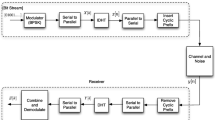Abstract
A precise method for the performance of a new DCT based OFDM system using a low complexity T-transform that combines the WHT and the DCT into a single fast orthonormal unitary transform (T-DCT) on AWGN and Rayleigh fading channels is proposed. The T-transform is developed through the sparse matrices factorization using tensor product scheme. Several signaling formats such as quadrature phase shift keying and 16-ary quadrature amplitude modulation are considered. Theoretical analysis of the T-transform for DCT based OFDM is presented in this work. Analysis and simulation results demonstrated that the proposed OFDM system achieves lower PAPR and the better BER over AWGN and Rayleigh fading channels. Compared to T-DFT of OFDM, T-DCT of OFDM is found to have lower PAPR and better BER therefore, T-DCT OFDM system outperforms the T-DFT OFDM on AWGN and Rayleigh fading environments. Simulation results are used to examine and compare the PAPR and the BER performance of T-DCT OFDM system and T-DFT OFDM system. Numerical results show that the T-DCT OFDM system outperforms the T-DFT OFDM system on AWGN and Rayleigh channel models.









Similar content being viewed by others
References
Liu, H., & Li, G. (2005). OFDM-based broadband wireless networks; Design and optimization. New Jersey: Wiley.
Proakis, J. G., & Salehi, M. (2008). Digital communication (5th ed.). New York: McGraw-Hill.
Digital video broadcasting (DVB). (2011). Frame structure, channel coding and modulation for a second generation digital terrestrial television broadcasting system (DVB-T2), ETSI EN 302 755, V1.2.1, European Telecommunications Standards Institute, Feb 2011.
Wireless LAN medium access control (MAC) and physical layer(PHY) specifications. (2009). Enhancement for higher throughput, IEEE Standard 802.11n.
IEEE standard for broadband over power line networks. (2010). Medium access control and physical layer specifications, IEEE standard 1901.2010, Dec 2010.
Very high speed digital subscriber line 2 (VDSL2). (2006). ITU-T recommendation G.993.2.
IEEE standard for local and metropolitan area networks. (2009). Part 16:Air interface for broadband wireless access systems, IEEE standard 802.16e, May 2009.
Evolved universal terrestrial radio access (E-UTRA). (2008). Physical channels and modulation, 3 GPP, TS 36.211, v 8.4.0, 3 GPP technical specification, Sep 2008.
Tan, P., & Beaulieu, N. C. (2006). A comparison of DCT-based OFDM and DFT-based OFDM in frequency offset and fading channels. IEEE Transactions Communications, 54(11), 2113–2125.
Attallah, S., & Nilsson, J. E. M. (1998). Sequences leading to minimum peak-to-average power ratios for DCT-based multicarrier modulation. Electronics Letters, 34(15), 1469–1470.
Jiang, T., & Wu, Y. (2008). An overview: Peak-to-average power ratio reduction techniques for OFDM signals. IEEE Transactions on Broadcasting, 54(2), 257–268.
Al-Dhahir, N., Minn, H., & Satish, S. (2006). Optimum DCT-based multicarrier transceivers for frequency-selective channels. IEEE Transactions and Communications, 54(5), 911–921.
Gao, F., Cui, T., Nallanathan, A., & Tellambura, C. (2008). Maximum likelihood based estimation of frequency and phase offset in DCT OFDM systems under non-circular transmissions: Algorithms, analysis and comparisons. IEEE Transactions and Communications, 56(9), 1425–1429.
Cruz-Roldan, F., Dominguez-Jimenez, M. E., Sansigre Vidal, G., Amo-Lopez, P., Blanco-Velasco, M., & Bravo-Santos, Á. (2012). On the use of discrete cosine transforms for multicarrier communications. IEEE Transactions on Signal Processing, 60(11), 6085–6090.
Boussakta, S., & Holt, A. G. J. (1989). Fast algorithm for calculation of both Walsh–Hadamard and Fourier transforms (FWFTs). IEEE Electronics Letters, 25(20), 1352–1354.
Ahmed, M. S., Boussakta, S., Sharif, B., & Tsimenidis, C. C. (2011). OFDM based on low complexity transform to increase multipath resilience and reduce PAPR. IEEE Transactions on Signal Processing, 3(6), 2013–2018.
Deepa, T., & Kumar, R. (2014). Application of the joint fast Walsh Hadamard-inverse fast Fourier transform in a LDPC coded OFDM wireless communication system: Performance and complexity analysis. International Journal of Wireless Personal Communications, 77(4), 3177–3192. doi:10.1007/s11277-014-1702-6.
Rao, K. R., & Yip, P. (1990). Discrete cosine transform: Algorithms, advantages, applications. Boston, MA: Academic Press.
Rama Murthy, N., & Swamy, M. N. S. (1993). On a novel decomposition of the DCT and its application. IEEE Transactions on Signal Processing, 41(1), 480–485.
Srinivasan, R., & Rao, K. (1983). An approximation to the discrete cosine transform for N = 16. Signal Processing, 5(1), 81–85.
Robinson, G. (1972). Logical convolution and discrete walsh and fourier power spectra. IEEE Transactions on Audio and Electroacoustics, 20(4), 271–280.
Kwak, H. S., Srinivasan, R., & Rao, K. R. (1983). C-Matrix transform. IEEE Transactions on Acoustics Speech and Signal Processing, 31(5), 1304–1307.
Author information
Authors and Affiliations
Corresponding author
Rights and permissions
About this article
Cite this article
Deepa, T., Kumar, R. An Efficient Low Complexity Transform for DCT-OFDM Based Wireless Communication System. Wireless Pers Commun 82, 201–214 (2015). https://doi.org/10.1007/s11277-014-2203-3
Published:
Issue Date:
DOI: https://doi.org/10.1007/s11277-014-2203-3




